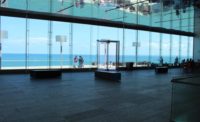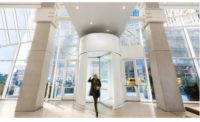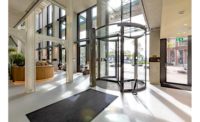The National Law Enforcement Museum in Washington, D.C. offers citizens and law enforcement professionals a place to share in the vibrant story of American law enforcement.
The museum, which opened in October 2018, is located in Judiciary Square, across from the National Law Enforcement Officers Memorial, and just blocks from the National Mall and numerous D.C. landmarks. It tells the story of American law enforcement by providing visitors with a “walk in the shoes” experience. It is dedicated to expanding and enriching the relationship shared by law enforcement and the community through educational journeys, immersive exhibitions and insightful programs and community partnerships. It houses more than 21,000 objects from every era of law enforcement in multiple exhibits.
The design and construction of the museum is uniquely modern. First, the 55,000 square foot museum is mostly located underground. The museum is only visible via two, all-glass pavilions that mark its presence on the street.
While the museum’s exterior is contemporary, with an all-glass facade that allows for ample light, the exterior fits in with the architecture of the other buildings in the area. “We had to go through a very strict design process with the architects and with the District of Columbia, the Commission of Fine Arts, and the Washington D.C. Historical Preservation Office,” said Paul Larson, senior director of security and museum operations for the museum.
The museum has quickly become a popular visitor attraction — on average, 300 to 500 visitors tour it each day. The two pavilions are the primary entrance and exit for visitors to the museum. The East Pavilion welcomes visitors and directs them to a security screening area and then downstairs to the Visitor Services area where they enter the exhibits area. Visitors exit from the West Pavilion.
The museum needed two door solutions that would allow for high traffic throughput on a daily basis, would fit into the design elements, and would be energy efficient in both hot and cold weather.
The museum’s architect chose two Boon Edam BoonAssist TQ manual revolving doors with all glass doorwings to achieve those goals. The doors are constructed primarily from glass with only a few stainless steel components to ensure structural strength. Their design fits seamlessly with modern glass facades such as the museum’s pavillions, or in more traditional or classic building designs. A BoonAssist revolving door has a low-energy drive to assist users as they push the door wings, as well as speed control for safety and automatic positioning back to “home” position when the door is not in use. The positioning feature maximizes the air seal to prevent unwanted air infiltration from the outdoors.
Larson has been impressed with the Boon Edam doors. “The doors are performing at a very high level, standing up to the high visitor traffic, and they look great,” Larson says. “The lighting inside of the doors makes the two glass pavilions really pop, especially at night.”









